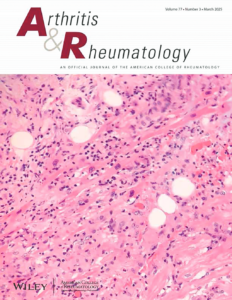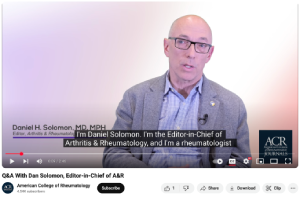 Arthritis & Rheumatology (A&R) is the flagship journal of the ACR, with articles covering common and rare rheumatic diseases, as well as clinical and translational aspects of rheumatic disease science. The current editor in chief of A&R, Daniel H. Solomon, MD, MPH, is a professor of rheumatology at Harvard Medical School, Boston, and holds the Matthew H. Liang Distinguished Chair in Arthritis and Population Health in Rheumatology at Brigham and Women’s Hospital, Boston.
Arthritis & Rheumatology (A&R) is the flagship journal of the ACR, with articles covering common and rare rheumatic diseases, as well as clinical and translational aspects of rheumatic disease science. The current editor in chief of A&R, Daniel H. Solomon, MD, MPH, is a professor of rheumatology at Harvard Medical School, Boston, and holds the Matthew H. Liang Distinguished Chair in Arthritis and Population Health in Rheumatology at Brigham and Women’s Hospital, Boston.
Dr. Solomon has spent some 15 years working as co-editor, deputy editor and—since 2020—editor in chief of A&R. This summer, he will pass the reins to S. Louis Bridges Jr., MD, PhD, physician in chief and chair of the Department of Medicine, and the Franchellie M. Cadwell Professor of Medicine at the Hospital for Special Surgery (HSS), New York. Dr. Bridges is also chief of the Division of Rheumatology at both HSS and Weill Cornell Medical College.
As Dr. Solomon begins to wrap up his years of service with A&R, The Rheumatologist (TR) asked him to discuss some of the journal’s new features and directions, his approach to ensuring readers have access to peer-reviewed, salient articles that advance the science and practice of rheumatology, and his thoughts about A&R’s future.
TR: To start off, how would you describe A&R and its value?
Dr. Solomon: A&R really tries to represent all rheumatologic practice and rheumatologic research. So we don’t just publish articles on the top diseases, such as rheumatoid arthritis (RA), psoriatic arthritis, lupus and osteoarthritis, but also on rare diseases (e.g., scleroderma) and less rare diseases (e.g., juvenile idiopathic arthritis).
In the past five years, we’ve covered 40–50 different rheumatic diseases, with about 50% of our articles on clinical science, including trials and epidemiology, and about 50% on translational science.
TR: Would you expand a bit on the translational articles the journal includes?
Dr. Solomon: The translational work underpins the science of rheumatology, so it is critical that rheumatologists understand these scientific trends. In this way, the journal helps inform research, as well as clinical practice.
When considering a manuscript, I always ask whether an article has a potential role in impacting clinical practice. That means making sure our articles are not too far away from the clinic in time or space. This [approach] ensures our clinical readership will say, ‘Oh, that’s really interesting, I wonder how that’s going to play out,’ and the researchers who read the journal will say, ‘Oh, that’s really important for what I’m doing today.’
There are no hard-and-fast rules in determining what should be published in A&R. Of course, that’s much to the chagrin of many authors, but that’s what an editor in chief has to learn and feel comfortable doing. Fortunately for authors, there are many very good rheumatology journals available. So if A&R turns down an article, authors have plenty of options to get their work published.
TR: A&R has a long reputation as a premier rheumatic disease journal, and it is constantly evolving. One of the newer features is called Notes from the Field, which you started in 2019 with the help of Rick Bucala, MD, PhD, former editor in chief of A&R. [Dr. Bucala is Waldemar Von Zedtwitz Professor of Medicine, professor of Pathology and of Epidemiology & Public Health, chief of the Rheumatology, Allergy & Immunology section at Yale School of Medicine, New Haven, Conn., affiliated faculty, Yale Institute for Global Health, and rheumatologist in chief of the Yale New Haven Health system.] What is Notes from the Field?
Dr. Solomon: Notes from the Field runs about every other month and is a place for commentaries. We are not looking for comments about a published paper. Instead, Notes from the Field provides clinicians, practitioners, researchers and health policy advocates a chance to provide expert opinions on a relevant topic for rheumatology. For instance, we have recently published commentaries on biosimilar prescriptions, long COVID and VEXAS.
TR: Another feature, called Expert Perspectives on Clinical Challenges, has been added to A&R during your tenure. Would you provide a little detail on that?
Dr. Solomon: Expert Perspectives on Clinical Challenges is just as it sounds: clinical review articles about how experts respond to common, but challenging, clinical scenarios—the kinds of scenarios that all clinicians face now and again. For example, this [feature] wouldn’t be an article about how to treat RA, but rather about how an expert clinician treated a patient with RA [that had impacted the lungs] and who wasn’t responding to anything else.
We ask the authors to take us through their logic, to review their practice and to provide the evidence basis for [the therapy]. These reviews recognize that the evidence base is not airtight because these [cases] are usually scenarios in which there aren’t perfect data and the clinician has to infer [therapeutic options] from published papers.
For Expert Perspectives on Clinical Challenges, authors review prior studies and then talk about how those studies informed their practice. We ask them to provide an algorithm that helps them decide what they do when a condition progresses to a certain stage in a similar subset of patients.
The point is to give the perspective of an expert colleague to fellows, trainees or any clinicians, regardless of their level of experience.
TR:So would this be akin to popping your head into the office of an expert rheumatologist and getting their thoughts on what they would do with a difficult case?
Dr. Solomon: Exactly. I’m lucky because I practice at Brigham and Women’s Hospital, which is like rheumatology central. I can walk down the hall and knock on lots of experts’ doors. Most people don’t have that luxury.
Readers like these Expert Perspectives, and we hope trainees are finding them useful. The articles are not going to be our most widely cited papers, and they’re not meant to be. Rather, these are papers that our clinical audience reads and uses in their practices, so they are important to provide.
TR: Would you like to highlight any other initiatives under way at the journal?
Dr. Solomon: One of the things we’ve done for the past year-and-a-half is a type of review article that we call Immunology for the Rheumatologist (https://acrjournals.onlinelibrary.wiley.com/doi/10.1002/art.42688).
There are a lot of advances in rheumatology that are beyond what most of us learned in medical school, and it’s hard to keep up with them if you’re not an immunologist. But at the same time, immunology underpins rheumatology, so all rheumatologists want some basic understanding of the current state of affairs for immunology.
What we do in these approximately bimonthly articles is address immunology through the context of a case, which is more interesting and more easily digested than reading a typical, dry immunology textbook.
TR: Can you provide an example?
Dr. Solomon:Sure. Let’s say you have a patient with lupus nephritis and are thinking about using drug X. An Immunology for the Rheumatologist article would discuss the immunologic basis of drug X for these patients, how the drug works and what’s going on in the kidney when patients take that drug.
The idea is to weave immunology into clinical practice for clinicians. (Editor’s note: See the summaries of these articles: www.the-rheumatologist.org/tag/immunology.)
TR: You will be wrapping up your tenure as editor in chief of A&R in summer 2025. What has been your journey in the field, and how did it lead to editing A&R?
Dr. Solomon: I got involved in rheumatology during medical school and residency because of some excellent mentors at Brigham and Women’s Hospital and Harvard Medical School who taught me about the excitement around clinical rheumatology, [as well as] the challenges and significance around clinical research in rheumatology.
On the clinical side, I have had the privilege of actually making people more comfortable and more functional, decreasing disability and improving their quality of life. It’s incredibly gratifying to be able to offer that to patients.
As a clinical researcher, I had the good fortune of getting very interested in drug safety epidemiology—pharmacoepidemiology—when I was in training and then focusing on drug epidemiology when I was pursuing my master’s in public health in 1998. The timing was excellent for that because it was when biologic [disease-modifying anti-rheumatic drugs] were being developed, along with selective COX-2 inhibitors, such as rofecoxib (Vioxx) and celecoxib (Celebrex). So I got to be right in the thick of it when we were trying to figure out if these new drugs were safe. That [experience] set me on a trajectory of doing what I like to think of as important clinical research in rheumatology.
It was about 2010 when I got involved with the ACR journals and became co-editor of A&R. That was during Joan Bathon’s tenure as editor in chief. [Author’s note: Joan Bathon, MD, is a professor of medicine in the Division of Rheumatology, Columbia University Vagelos College of Physicians and Surgeons, New York.] It was an opportunity for me to learn how the journal works, including the decisions editors need to make.
And then during Rick Bucala’s time as the editor in chief, between 2015 and 2020, I served as A&R’s deputy editor, which gave me a slightly enhanced role. It was interesting work, and I obviously enjoyed it because I decided to apply to become the journal’s editor in chief at the end of Rick’s term. I felt very fortunate to be appointed editor in chief in 2020.
TR: What is in store for A&R?
Dr. Solomon: A lot has been going on during my term as editor in chief. For instance, we have been working quite hard on shortening our time from acceptance to online publication and have already dropped from 60–70 days to 30–40 days. We hope to improve that even more. We’ve also developed a very nice method for authors to show their work in graphical abstract form, and our staff has done a very good job of generating an additional channel on social media so authors can let the world know about their important research.
While continuing to work on that, we’re also in the midst of revamping our website to make it much more interactive, including things like slide collections, videos, cases, etc., so it transforms from an article archive, which is what it is now, and becomes a learning center.
There is one thing we need to address regarding the future. Although A&R has a very high profile, it and the ACR’s other two official journals—Arthritis Care & Research and ACR Open Rheumatology—are facing headwinds on several fronts: gold open access journals that make articles immediately and freely available online and may reduce subscriptions, a primary revenue stream; the growing number of so-called predatory journals that publish just about anything; and mounting concerns that some of the papers being submitted for publication are not written by humans, but instead by artificial intelligence-powered content generators. These are serious challenges that need to be recognized and acted upon, specifically by giving appropriate support to our journals in terms of personnel, staff and resources to ensure they continue to thrive.
That said, A&R is in great shape today, and the next editor in chief, Lou Bridges, is a very well-respected and smart guy who will introduce some of his own improvements to the journal when he takes the reins this year.
TR: How do you feel about ending your editorial role at A&R?
Dr. Solomon: I do have some mixed feelings about passing the baton. After all, A&R has been my baby for nearly five years now. My wife might call it my ball and chain. I’ve been very involved in A&R over the prior 10 years, so the idea of not having the journal on my to-do list is a little sad. But it is a little bit liberating, too.
In preparation, Lou and I have been talking about the transition, and I am sure he will be a strong editor in chief.
Leslie Mertz, PhD, is a freelance science journalist based in northern Michigan.
A&R Online
Gain access to the Arthritis & Rheumatology full journal archive online at: https://acrjournals.onlinelibrary.wiley.com/journal/23265205.





